 January 12, 2017 John E. Ross, KD8IDJ, Editor
| ||||||
Illegal Drone Transmitters Could Interfere with Air Traffic Control, ARRL Complaint Asserts In what it calls an "extremely urgent complaint" to the FCC, ARRL has targeted the interference potential of a series of audio/video transmitters used on unmanned aircraft and marketed as Amateur Radio equipment. In a January 10 letter to the FCC Spectrum Enforcement Division, ARRL General Counsel Chris Imlay, W3KD, said the transmitters use frequencies intended for navigational aids, air traffic control radar, air route surveillance radars, and global positioning systems.
ARRL said the use of 1,040 and 1,080 MHz, which would directly conflict with air traffic control transponder frequencies, represented the greatest threat to the safety of flight. The use of 1,010 MHz, employed for aeronautical guidance, could also be problematic. ARRL cited the Lawmate transmitter and companion 6 W amplifier as examples of problematic devices being marketed in the US. Each costs less than $100 via the Internet. The device carries no FCC identification number. "[T]he target market for these devices is the drone hobbyist, not licensed radio amateurs. The device, due to the channel configuration, has no valid Amateur Radio application," ARRL told the FCC. "While these transmitters are marked as appropriate for amateur use, they cannot be used legally for Amateur Radio communications." In the hands of unlicensed individuals, the transmitters could also cause interference to Amateur Radio communication in the 1.2 GHz band, ARRL contended. The League said it's obvious that the devices at issue lack proper FCC equipment authorization under FCC Part 15 rules, which require such low-power intentional radiators to be certified.
"Of most concern is the capability of the devices to cripple the operation of the [air traffic control] secondary target/transponder systems," ARRL said. "These illegal transmitters represent a significant hazard to public safety in general and the safety of flight specifically." The surge in sales of drones has been dramatic. The FAA has predicted that combined commercial and hobby sales will increase from 2.5 million in 2016 to 7 million by 2020. In Exhibit A of the January 10 letter, "Illegal Drones Threaten Public Safety," the League noted that some of the drones and associated equipment it has come across "are blatantly illegal at multiple levels," with some drone TV transmitters described as "particularly alarming." "Rated at six times over the legal power limit, and on critical air navigation transponder frequencies, these devices represent a real and dangerous threat to the safety of flight, especially when operated from a drone platform that can be hundreds of feet in the air," the exhibit narrative asserted. FCC Dismisses Two Petitions from Radio Amateurs The FCC has turned down two petitions filed in 2016, each seeking similar changes in the Part 97 Amateur Service rules. James Edwin Whedbee, N0ECN, of Gladstone, Missouri, had asked the Commission to amend the rules to reduce the number of Amateur Radio operator classes to Technician, General, and Amateur Extra by merging remaining Novice class licensees into the Technician class and all Advanced class licensees into the Amateur Extra class. In a somewhat related petition, Jeffrey H. Siegell, WB2YRL, of Burke, Virginia, had requested that the FCC grant Advanced class license holders Morse code operating privileges equivalent to those enjoyed by Amateur Extra class licensees.
The FCC streamlined the Amateur Radio licensing system into three classes -- Technician, General, and Amateur Extra -- in 1999. While it no longer issues new Novice or Advanced class licenses, existing licenses can be renewed, and Novice and Advanced licensees retained their operating privileges. "The Commission concluded that the three-class structure would streamline the licensing process, while still providing an incentive for licensees to advance their communication and technical skills," the FCC recounted in its dismissal letter to Whedbee and Siegell. It specifically rejected suggestions that Novice and Advanced class licensees be automatically upgraded to a higher class, concluding that it would be inappropriate for these licensees to "receive additional privileges without passing the required examination elements." The FCC cited the same reason in 2005, when it denied requests to automatically upgrade Technician licensees to General class and Advanced licensees to Amateur Extra class, as part of a wide-ranging proceeding. The FCC said the two petitions "do not demonstrate, or even suggest, that any relevant circumstances have changed that would merit reconsideration of those decisions." Read more. President Obama Renominates FCC Commissioner Jessica Rosenworcel President Barack Obama has renominated FCC Commissioner Jessica Rosenworcel, a Democrat, for a new term. She joined the FCC in 2012, and her tenure ended on January 3. Rosenworcel's renomination last fall failed to gain Senate approval before adjournment, and it had been thought that Rosenworcel would depart the Commission by the end of 2016.
With FCC Chairman Tom Wheeler stepping down on January 20, the FCC will be left with two Republicans -- Ajit Pai and Michael O'Rielly -- and, unless Rosenworcel is confirmed, one Democrat -- Mignon Clyburn, whose term ends in mid-2017. The FCC can have up to five commissioners, and no more than three may belong to the same political party. Wheeler applauded Rosenworcel's reappointment and said he hoped Congress would "act quickly to confirm her nomination." With President Obama leaving on January 20, however, action on reconfirming Rosenworcel for a new term is not expected until President-Elect Donald Trump takes office. Nevada ARES Stands Down as Flood Threat Abates Amateur Radio Emergency Service (ARES®) volunteers and emergency operations centers (EOCs) in Nevada stood down this week as the threat of additional widespread flooding damage diminished. Over the weekend, ARES members in Nevada stood ready to support the disaster response effort. Recent heavy rainfall, sparked by a weather system called the Pineapple Express, caused flooding along rivers and forced evacuations in some areas of Nevada and neighboring California. The flooding prompted Nevada Gov. Brian Sandoval to declare a state of emergency. In Reno, the Truckee River crested above 12 feet on January 9, and at 19.5 feet in Sparks.
Because forecasters were able to detect and predict the magnitude of the storm well in advance, the Reno area had time to prepare, and sandbagging and other operations were in full force last Friday. County EOCs such as the Regional Emergency Operations Center (REOC), which serves as a joint facility for Washoe County and the cities of Reno and Sparks, began activating early on Friday morning. ARES volunteers took up positions at the REOC as well as in Storey, Lyon, and Douglas counties. Under the direction of Section Emergency Coordinator Glenn Hale, KB7REO, ARES volunteers in the rest of Nevada's counties began monitoring emergency activations on HF, Echolink, IRLP, and DMR. Shelters were opened in two Reno high schools, and voluntary evacuations were begun. Throughout the weekend, ARES communicators remained on duty. On Sunday, the fire station at Truckee Meadows experienced a power failure and lost communication. Washoe County Emergency Coordinator Bob Miller, WA6MTY, dispatched an ARES volunteer to the station to provide communication. A statewide ARES resource net supported the response, with 60 meters and Winlink added to the toolbox. The statewide net included the California counties of Alpine, Mono, and Inyo, which operate by prior agreements within the Nevada Section as the Sierra East District because the Sierra Nevada mountain range makes it impossible for them to communicate with their own California sections. Read more. -- Thanks to John Bigley, N7UR/The Nevada Amateur Radio Newswire The Doctor Will See You Now! "Long Delayed Echoes" is the topic of the latest (January 12) episode of the "ARRL The Doctor is In" podcast. Listen...and learn!
Every 2 weeks, your host, QST Editor-in-Chief Steve Ford, WB8IMY, and the Doctor himself, Joel Hallas, W1ZR, will discuss a broad range of technical topics. You can also e-mail your questions to doctor@arrl.org, and the Doctor may answer them in a future podcast. Enjoy "ARRL The Doctor is In" on Apple iTunes, or by using your iPhone or iPad podcast app (just search for "ARRL The Doctor is In"). You can also listen online at Blubrry, or at Stitcher (free registration required, or browse the site as a guest) and through the free Stitcher app for iOS, Kindle, or Android devices. If you've never listened to a podcast before, download our beginner's guide. New Digital Modes Gain Traction for Moonbounce, but Occasionally Show Up on HF In December, Joe Taylor, K1JT, released the latest version (1.7) of his WSJT-X software suite, designed to facilitate basic Amateur Radio communication using very weak signals ("WSJT" stands for "Weak Signal communication by K1JT"). Version 1.7 included the new modes MSK144 and QRA64, as well as ISCAT (ionospheric scatter). MSK144 and QRA64 (and QRA64A) are finding a home within the VHF Earth-Moon-Earth (EME, or moonbounce) and meteor-scatter communities, but QRA64A signals also have turned up on 160 meters, which poses its own challenges to weak signals.
But Taylor does not advise a wholesale shift to the use of QRA64 on the HF bands -- at least just yet. "It's okay to play with and test QRA64 at HF, if you wish," he commented recently on the WSJT Development discussion group. "Some of our earliest tests of the mode were done on the 20-meter and 30-meter bands." He suggested, though, that HF operators stick with JT65, "not least because, at present, we have included no 'multi-decode' capability for the QRA64 decoder. It's made to decode just one signal in the passband." In the WSJT-X Version 1.7 User Guide, Taylor pointed out QRA64's several advantages over JT65, including better performance on the very weakest signals. "We imagine that, over time, it may replace JT65 for EME use," he wrote. "JT9 was originally designed for the LF, MF, and lower HF bands. Its submode JT9A is 2 dB more sensitive than JT65, while using less than 10% of the bandwidth." Taylor told ARRL that he expects JT65 and JT9 to remain the preferred modes for making "minimal QSOs" at HF for some years to come. "QRA64 is 1-3 dB more sensitive than JT65 or JT9; this is important for EME, but much less so at HF, because one can usually run 20 W instead of 10 W, when the going gets rough."
These modes use 1-minute timed sequences of alternating transmission and reception, so a basic contact can take up to 6 minutes -- two or three transmissions by each station, one transmitting on odd UTC minutes and the other on even. A typical contact uses canned message text to exchange grid squares and signal reports. Paul Andrews, W2HRO, said in a January 10 post to the Moon-Net reflector that he develops "free-form" QRA64 messages to make his contacts more like ragchews. "Tonight I was able to ragchew via 2-meter EME," he said. "My QRA64 free-form messages actually confused monitoring stations, because they have never seen ragchew free form." Andrews said he likes the idea of taking advantage of good conditions to carry out a conversation via EME, rather than just validating the exchange of signals. Read more. Radio Club of America Announces New "Wireless Women" Section on Website In an effort to encourage more participation of women and girls in the wireless industry, the Radio Club of America (RCA) has created a new "Wireless Women" section on its website, designed to assist women considering careers in wireless and encouraging them to get involved in technology. Information includes resources such as "Notable Women in Wireless," "RCA's Vivian Carr Award," and "Professional Wireless Organizations for Women," as well as web resources for women and girls interested in wireless. There's also a list of universities that have an engineering focus and significant enrollment by women.
Duffy credited the efforts of several female RCA members, including Secretary Margaret Lyons P.E., Executive Committee member and Marketing & Development Committee Chair Elaine Walsh, former RCA president Mercy Contreras, and others, for assembling the information that might be useful to women and girls who are interested in wireless. "We welcome additional ideas or input from the wireless community to help this section of our website become more useful," Duffy said. The Yasme Foundation Announces Excellence Awards, Supporting Grants The Yasme Foundation has announced excellence awards to two individuals and supporting grants to six organizations. The Yasme
The Yasme Excellence Award is in the form of a cash grant and an engraved crystal globe. The Yasme Foundation supporting grants recognize furtherance of the Foundation's goal of supporting the development of Amateur Radio. These organizations received grants:
For additional information about The Yasme Foundation, visit its newly updated website. -- Thanks to Ward Silver, N0AX Warm Up with the January VHF Contest, January 21-23 If you're feeling a chill in the air, it must be time for the January VHF Contest! Those in the northern tier of the US (or in a good part of the US this winter) are experiencing brisk winds, temperatures dipping southward, piles of snow or ice, or heavy rain. This means the ARRL January VHF Contest is near. What a great way to warm up for the 2017 VHF+ contest season, even if it's already warm where you live. This annual event begins at 1900 UTC on Saturday, January 21, and it wraps up at 0359 UTC on Monday, January 23.
The objective is for amateurs in the US and Canada (and territories) to work as many stations in as many different Maidenhead grid squares as possible, using frequencies above 50 MHz -- often while trying to stay warm. Contest contacts may be made using SSB, CW, digital modes, and even FM simplex. The January VHF Contest offers Single Operator and Multioperator categories. What's really cool about this contest are the three Single Operator categories, inviting to newcomers and seasoned VHFers alike: FM-only, 3-Band (50 MHz, 144 MHz, and 440 MHz), and Portable. The rules spell out the details for these as well as for other Single Operator, Rover, and Multioperator entry categories. "We've seen some very strong numbers of participants and healthy scores recently in the FM-only category," said ARRL Contest Branch Manager Bart Jahnke, W9JJ. "The number of Portable and Rover stations -- and their accomplishments -- has been amazing, even in the January event." Getting on the VHF/UHF bands is not hard. Technician licensees have access to all amateur bands above 50 MHz. Antennas for VHF/UHF frequencies are available new or used, and you can even roll your own. Kent Britain, WA5VJB, offers useful information on his website on how to make your own "cheap Yagis." Another approach is the Quagi antenna. Wayne Overbeck, N6NB, provides an overview on his website. For UHF+, loop Yagis are relatively simple to build, and designs are readily available. Even some HF antennas will work on 6 meters. All contest entries must be uploaded via the web app or e-mailed to the contest robot by 0359 UTC on February 22. Mail paper logs to ARRL January VHF Contest, 225 Main St., Newington, CT 06111. Contact the ARRL Contest Branch for more information. Winter Field Day is Just Ahead Field Day is not just for summertime anymore. Winter Field Day, sponsored by the Winter Field Day Association (WFDA), will take place over the January 28-29 weekend, and it can be a terrific time to prep for ARRL Field Day in June. The annual event's stated purpose is to encourage emergency operating preparedness in the winter, but it's also an excuse to get out of the house and enjoy the great outdoors. According to the WFDA, getting ready for emergency communication in a winter environment is just as important as the preparations and practice that take place each June during ARRL Field Day, and -- let's face it -- it's not cold and snowy everywhere during the winter months. Your local climate could be quite the opposite.
The event, which got its start in 2007, is not restricted to North America. All Amateur Radio operators around the world are invited to participate, and there are three entry categories -- indoor, outdoor, and home. The rules are similar to those for ARRL Field Day. Operation will take place on all HF bands except 12, 17, 30, and 60 meters, as well as on VHF, UHF, and satellite. The event runs 24 hours. US and Canadian stations exchange call sign, operating category, and ARRL or RAC section. The WFDA encourages both group and solo operation, and if you're not up for an outdoor winter adventure involving Amateur Radio, you can operate from the comfort of your shack. As the WFDA says on its Facebook page, "The object is winter fun!" In Brief...
The K7RA Solar Update Tad Cook, K7RA, Seattle, reports: No sunspots are currently visible, and none have been seen since January 3, when just one sunspot appeared. There were none on January 1-2. The Daily Solar Data from NOAA's Space Weather Prediction Center is full of zeroes.
Predicted solar flux is 74, 73, and 75 on January 12-14; 78 on January 15-19; 76 on January 20-25; 74 on January 26-28; 73 on January 29-February 1; 72 on February 2-7; 74 on February 8, and 76 on February 9-21. The predicted planetary A index is 10 on January 12; 8 on January 13-14; 5, 8, and 16 on January 15-17; 12 on January 18-19; 18 on January 20; 20 on January 21-22; 10 on January 23; 5 on January 24-26; 12, 15, 7, 10, and 12 on January 27-31; 16, 18, 20, 16, 12, and 5 on February 1-6; 12, 15, 10, and 8 on February 7-10; 5 on February 11-12; 25, 20, 25, and 18 on February 13-16, and 20 on February 17-18.
Sunspot numbers for January 5-11 were 0, 0, 0, 0, 0, 0, and 0, with a mean of 0. The 10.7-centimeter flux was 73.3, 72, 72, 71.5, 71.2, 72.7, and 74.5, with a mean of 72.5. The estimated planetary A indices were 18, 16, 20, 16, 12, 10, and 8, with a mean of 14.3. Estimated mid-latitude A indices were 15, 14, 14, 11, 8, 5, and 7, with a mean of 10.6. Send me your reports or observations.
. . . . . .
Getting It Right! The story "Boy Scouts' Radio Merit Badge Requirements to Include Amateur Radio Direction Finding Option," in the January 5 edition of The ARRL Letter, included some errors. While requirements for the Radio merit badge have been updated, ARDF is an option, not a requirement. Cellular telephones and different types of radio modulation are required topics, however. The new requirements became effective January 1, 2017. ARDF activities already take place at Jamboree on the Air (JOTA) events and at summer camps. Just Ahead in Radiosport
See the ARRL Contest Calendar for more information. For in-depth reporting on Amateur Radio contesting, subscribe to The ARRL Contest Update via your ARRL member profile e-mail preferences. Upcoming ARRL Section, State, and Division Conventions
Find conventions and hamfests in your area.
. .
Subscribe to...
Free of charge to ARRL members...
| ||||||
 "This is, in ARRL's view, a potentially very serious interference problem, and it is respectfully requested that the products referenced...be investigated and removed from the marketplace immediately and that the importers be subjected to normal sanctions," ARRL's letter said. Some of the transmitters operate on frequencies between 1,010 and 1,280 MHz. "These video transmitters are being marketed ostensibly as Amateur Radio equipment," the League said, "but of the listed frequencies on which the devices operate, only one, 1,280 MHz, would be within the Amateur Radio allocation at 1,240-1,300 MHz." Even then, ARRL said, operation there would conflict with a channel used for radio location.
"This is, in ARRL's view, a potentially very serious interference problem, and it is respectfully requested that the products referenced...be investigated and removed from the marketplace immediately and that the importers be subjected to normal sanctions," ARRL's letter said. Some of the transmitters operate on frequencies between 1,010 and 1,280 MHz. "These video transmitters are being marketed ostensibly as Amateur Radio equipment," the League said, "but of the listed frequencies on which the devices operate, only one, 1,280 MHz, would be within the Amateur Radio allocation at 1,240-1,300 MHz." Even then, ARRL said, operation there would conflict with a channel used for radio location.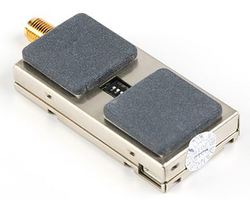
.jpg) "Thus, Mr. Siegell's proposed rule change is subsumed within the changes Mr. Whedbee requests, so our analysis is the same for both proposals," the FCC
"Thus, Mr. Siegell's proposed rule change is subsumed within the changes Mr. Whedbee requests, so our analysis is the same for both proposals," the FCC 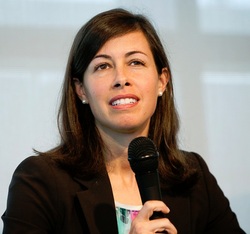
.jpg) Carrying moisture-laden warm air from Hawaii, the Pineapple Express "atmospheric river" flowing across a narrow band of the Sierra Nevadas brought snow followed by rainfall of up to 15 inches to northern Nevada and California. While the rainfall may have broken the back of the region's lengthy drought, it caused the snowpack in the Sierras to melt, initiating avalanches and mudslides, washing out roadways, and causing heavy flooding.
Carrying moisture-laden warm air from Hawaii, the Pineapple Express "atmospheric river" flowing across a narrow band of the Sierra Nevadas brought snow followed by rainfall of up to 15 inches to northern Nevada and California. While the rainfall may have broken the back of the region's lengthy drought, it caused the snowpack in the Sierras to melt, initiating avalanches and mudslides, washing out roadways, and causing heavy flooding..jpg) Sponsored by
Sponsored by 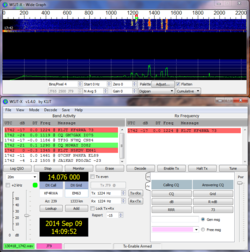 "QRA64A QSOs are being made nightly on 160 meters, of all places, and QRA64 activity on 2-meter EME is becoming significant, especially on weekends," Taylor remarked in a January 9 update posted to the Moon-Net reflector, pointing out that QRA64 is decoding signals down to about -28 dB signal-to-noise.
"QRA64A QSOs are being made nightly on 160 meters, of all places, and QRA64 activity on 2-meter EME is becoming significant, especially on weekends," Taylor remarked in a January 9 update posted to the Moon-Net reflector, pointing out that QRA64 is decoding signals down to about -28 dB signal-to-noise.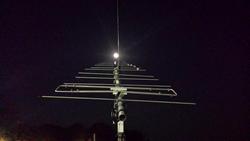
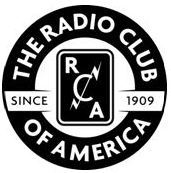 "RCA has a long history of recognizing the achievements of women in wireless," RCA President Tim Duffy, K3LR, said. "Three former RCA presidents are women, and we have many female officers, directors, and committee members. We created the Vivian Carr award in 2014 to recognize women who have contributed significantly to the wireless industry, and Director Carole Perry [WB2MGP] has led RCA's effort to educate youth about wireless for decades."
"RCA has a long history of recognizing the achievements of women in wireless," RCA President Tim Duffy, K3LR, said. "Three former RCA presidents are women, and we have many female officers, directors, and committee members. We created the Vivian Carr award in 2014 to recognize women who have contributed significantly to the wireless industry, and Director Carole Perry [WB2MGP] has led RCA's effort to educate youth about wireless for decades."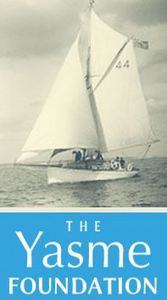 Excellence Award honors individuals who have made significant contributions to Amateur Radio in terms of technical, operating, or organizational achievement. Recipients are:
Excellence Award honors individuals who have made significant contributions to Amateur Radio in terms of technical, operating, or organizational achievement. Recipients are: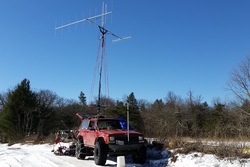
 "Don't let those winter doldrums keep you locked up in the house," the WFDA says. "Get out and play some radio!" The WFDA said it believes that maintaining operating skills should not be limited to fair-weather scenarios.
"Don't let those winter doldrums keep you locked up in the house," the WFDA says. "Get out and play some radio!" The WFDA said it believes that maintaining operating skills should not be limited to fair-weather scenarios.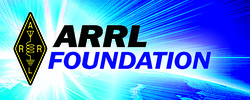 ARRL Foundation 2017-2018 Scholarship Application Deadline Looms: The deadline is Tuesday, January 31 (at 11:59 PM ET), to receive completed
ARRL Foundation 2017-2018 Scholarship Application Deadline Looms: The deadline is Tuesday, January 31 (at 11:59 PM ET), to receive completed .JPG) Inauguration Special Event Set: Radio amateurs in the Washington, DC, area, will operate special event station W3T January 19-21 to mark the inauguration of Donald J. Trump, Mike Lonneke, W4AAW, of Round Hill, Virginia, has announced. A group of more than 20 operators will staff the operation, and a commemorative QSL card will be available. Jim Nitzberg, WX3B -- who participated in the 2009 inaugural commemorative station -- recalled the special event was swamped by callers. Lonneke and Nitzberg are making their own stations available for the operation, and teams of seasoned contesters will be taking the helm for the W3T event. Richard Maylott, W2YE, will oversee the distribution of the anticipated thousands of commemorative QSL card requests. QSL direct with a self-addressed, stamped envelope ($2 for non-US requests) to 20732 Furr Rd., Round Hill, VA 20141-1803 or via the W3 QSL Bureau. -- Thanks to Mike Lonneke, W4AAW
Inauguration Special Event Set: Radio amateurs in the Washington, DC, area, will operate special event station W3T January 19-21 to mark the inauguration of Donald J. Trump, Mike Lonneke, W4AAW, of Round Hill, Virginia, has announced. A group of more than 20 operators will staff the operation, and a commemorative QSL card will be available. Jim Nitzberg, WX3B -- who participated in the 2009 inaugural commemorative station -- recalled the special event was swamped by callers. Lonneke and Nitzberg are making their own stations available for the operation, and teams of seasoned contesters will be taking the helm for the W3T event. Richard Maylott, W2YE, will oversee the distribution of the anticipated thousands of commemorative QSL card requests. QSL direct with a self-addressed, stamped envelope ($2 for non-US requests) to 20732 Furr Rd., Round Hill, VA 20141-1803 or via the W3 QSL Bureau. -- Thanks to Mike Lonneke, W4AAW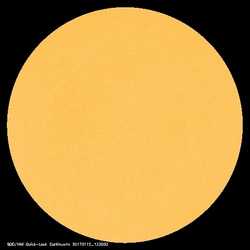 Average daily solar flux this week was 72.5, down from 73.1 a week earlier. The average planetary A index rose 5 points to 14.3, while the average mid-latitude A index increased from 6.3 to 10.6.
Average daily solar flux this week was 72.5, down from 73.1 a week earlier. The average planetary A index rose 5 points to 14.3, while the average mid-latitude A index increased from 6.3 to 10.6.








